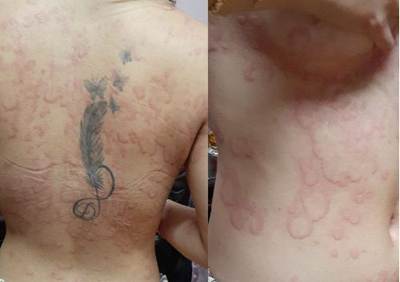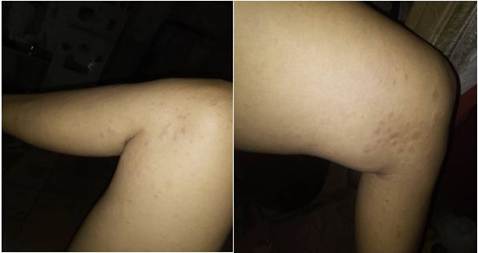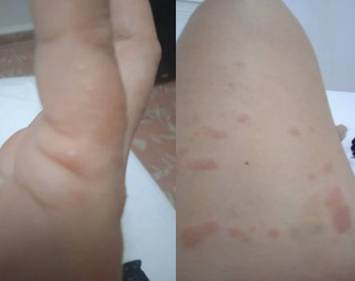Meu SciELO
Serviços Personalizados
Artigo
Indicadores
-
 Citado por SciELO
Citado por SciELO
Links relacionados
-
 Similares em
SciELO
Similares em
SciELO
Compartilhar
Revista de Ciencias Médicas de Pinar del Río
versão On-line ISSN 1561-3194
Rev Ciencias Médicas vol.26 no.5 Pinar del Río set.-out. 2022 Epub 01-Set-2022
Articles
Urticaria in COVID-19. Case series presentation
1University of Medical Sciences of Ciego de Avila. Julio Castillo" Teaching Polyclinic. Chambas. Ciego de Avila. Cuba
2University of Medical Sciences of Ciego de Avila. Arley Moreira School of Medical Sciences. Morón, Ciego de Avila, Cuba
Introduction:
COVID-19 is currently considered a florid pathology of mandatory multidisciplinary management by medical specialties. For the dermatologist it represents a diagnostic challenge, due to the heterogeneity of clinical descriptions found at cutaneous level in these patients, so it is important to be attentive to this health emergency, given that although the virus is not dermatotropic, every day there is more evidence of cutaneous lesions produced by the new coronavirus.
Case presentation:
the 3 cases were female patients, young women between 19 and 27 years of age, with a history of allergies in 2 of them, who developed urticarial wheals almost simultaneously with the rest of the symptoms with positive PCR of nasopharyngeal exudate for SARS-CoV-2, with satisfactory clinical evolution and remission of the symptoms on the seventh day.
Conclusions:
knowledge of the cutaneous manifestations allows to deepen in the still little-known aspects of COVID-19, to make a quicker diagnosis or even to serve as a prognostic marker. In the pandemic era, the diagnosis of infection should be considered in patients presenting with skin lesions, urticaria or angioedema with or without other symptoms and especially in those with atypical disease or with recent exposure to individuals infected by the virus.
Key words: COVID-19/urticaria; COVID-19/skin lesions; SARS-CoV-2
INTRODUCTION
In December 2019 in Wuhan City, China, covid-19 was first identified when a group of individuals with pneumonia of unknown cause were reported, the pathogen, a novel coronavirus called severe acute respiratory syndrome coronavirus 2 (SARSCoV-2), was isolated from lower respiratory tract specimens of infected patients. The World Health Organization, due to the rapid spread of the disease, on January 30, 2020, declared it a health emergency of international concern and recognized it as a pandemic on March 11.1 On that date, the first cases of contagion by the virus were also confirmed in Cuba.2
As of July 21, 2021, 191,281,182 cumulative confirmed cases of COVID-19 were reported globally, including 4,112,538 deaths, of which 39 % of the cases and 48 % of the deaths were in the Americas region.3 In Cuba, at the close of July 21, 2021, 191,281,182 confirmed cases of COVID-19 were reported globally, including 4,112,538 deaths.
In Cuba, at the close of October 21 of this year, of the 943,383,38 patients diagnosed with the disease, 6,38 remain hospitalized, of whom 5,866 have a stable clinical course. There are 8,153 deaths (20 on the day), with a mortality rate of 0,86 % vs. 2,03 % in the world and 2,45 % in the Americas. Ciego de Avila province has undergone a complex epidemiological situation in recent months.4
The clinical spectrum of COVID-19 is widely heterogeneous, with asymptomatic patients or with mild infections, up to critical or fatal forms with respiratory failure, septic shock or multiorgan dysfunction. The disease usually manifests with fever, cough, fatigue, anorexia, dyspnea, myalgias, ageusia, anosmia, pharyngodynia, headache, and chills;5 although cutaneous manifestations have also been documented.5,6
Urticaria is a cutaneous and mucosal disease characterized by the appearance of wheals or angioedema,7 which are conditions associated with mast cell degranulation and release of vasoactive substances (histamine) that act in the microcirculation, causing the presence of hives or disseminated wheals, increased volume of the lips, eyelids, hands and genitals. There may be laryngeal edema and other symptoms of anaphylaxis. They are of diverse nature: infectious (bacterial, viral or parasitic), physical, medicinal, alimentary, autoimmune, cancer and unknown.8
According to its duration, it has been classified as acute and chronic, the latter is defined as lasting more than six weeks. The prevalence of chronic urticaria is estimated to be between 0.5 and 5 % of the general population. According to some studies, the incidence in the U.S. population is approximately 1,4 % per year.7
It is important for the dermatologist to be attentive to this health emergency and its challenges, because although the virus is not dermatotropic, there is increasing evidence of skin lesions produced by the new coronavirus that require treatment by the skin specialist. Hence, the aim of this presentation is to report three cases of patients who presented with COVID-19-associated urticaria.
The patients signed their informed consent, ethical requirements were taken into account.
PRESENTATION OF CASES
Case 1: Patient DHA, female, 20 years old, white, medical student, with a personal history of atopic dermatitis since the first years of life, for which she is treated with antihistamines and steroid creams when outbreaks are triggered.
Family history: asthmatic mother, healthy father. She develops in an adequate family environment with good socio-economic conditions. In July of the present year she began with rhinitis and headache, on the second day of the onset she presented fever of 39 degrees and large urticarial wheals with intense pruritus scattered on face, trunk and upper and lower extremities (Fig. 1).
Due to the existing epidemiological situation, polymerase chain reaction (PCR) of nasopharyngeal exudate was performed for SARS-CoV-2 with positive result and high viral load (quantification/qualification cycle: CT=13) and leukogram showing mild leukopenia with lymphocytosis and eosinophilia.
Given the severity of the cutaneous symptoms, she was admitted to the emergency room of the Julio Castillo polyclinic and treated with parenteral hydration with 0,9 % chloro-sodium, epinephrine three tenths subcutaneous, diphenhydramine one ampoule every 6h and hydrocortisone 500mg diluted bolus, when the severity of the lesions decreased she was transferred to the isolation center for COVID-19 cases and continued with medical treatment: hypoallergenic diet, oral medication with H1 and H2 antihistamines (diphenhydramine 25mg every 6h and ranitidine 300mg per day), prednisolone 40mg/day in decreasing doses and hydrocortisone cream twice a day, the picture remits completely after a week without complications.
Case 2: Patient DFP, female, 19 years old, white, computer science student, with personal and family health history. She lives in an adequate family environment with good socio-economic conditions, she went for dermatological consultation in August of this year because she presented skin lesions in the form of small urticarial wheals on lower limbs with predilection on the thighs accompanied by pruritus, on interrogation she reported a fever of 37.3 degrees and headache the day before (Fig. 2).
Given the epidemiological situation in the country and in the municipality, nasopharyngeal exudate PCR was performed for SARS-CoV-2 with positive result, low viral load (CT=27) and normal leukogram. She was admitted to an isolation center for low-risk patients and was started on a hypoallergenic diet, nasalferon one drop in each nostril every 12h, diphenhydramine 25mg every 6h and steroid creams twice a day, the symptoms resolved after a week, without complications.
Case 3: Patient LMG, female, 27 years old, white, speech therapist by profession, with a personal history of allergic rhinitis for which she is under regular treatment with loratadine one tablet a day and family history of hypertensive mother, healthy father. She lives in an adequate family environment with good socio-economic conditions. She went for dermatological consultation in August of this year because she presented skin lesions in the form of disseminated urticarial wheals on the thighs and fingers, accompanied by intense pruritus. Upon questioning, she reported coryza and fever of 37,5 degrees (Fig. 3).
PCR of nasopharyngeal exudate was performed for SARS-CoV-2 with positive result, low viral load (CT=28) and leukogram with slight leukopenia. The patient was admitted to an isolation center for low-risk patients and was started on a hypoallergenic diet, nasalferon one drop in each nostril every 12h, diphenhydramine 25mg every 6h and hydrocortisone cream twice a day, the condition completely resolved after a week without complications.
DISCUSSION
The appearance of a new virus with high mortality and tropism for various tissues has attracted the attention of dermatologists worldwide, because the skin has not been exempt from this disease, so they began the publication of the various cutaneous manifestations that usually appear in patients with serological diagnosis or by PCR of positive exudate for SARS-COV-2 and cases related both epidemiologically and temporally.9
The skin, especially the mucous membranes, is an organ that very frequently presents viral infections. These infections may be primarily localized to the skin or manifest at the cutaneous-mucosal level as part of a general picture. It appears that the SARS-COV-2 virus activates complement, which is the body's first line of defense against microbes and can induce damage to the endothelium (which lines the vessels), triggering the coagulation system and leading to the formation of small clots in the blood vessels.10
Several mechanisms have been postulated to explain the skin lesions present in these patients, such as production of lymphocytic vasculitis, activation of Langerhans cells leading to vasodilatation and spongiosis, accumulation of microthrombi, disseminated intravascular coagulation, thrombogenic pauciinflammatory vasculopathy with deposition of C5b-9 and C4d along with co-localization with SARS-CoV-2 spike glycoproteins.11,12,13 The presence of dermatologic manifestations may contribute to the early diagnosis or constitute a prognostic marker of COVID-19 infection.11
In this case series, patients develop urticarial wheals of varying intensity associated with SARS-CoV-2 virus infection, no history of previous use of medications, consumption of allergenic foods or other causes that could explain the clinical picture was collected, patients evolve without complications with remission of the picture in about seven days.
Cabezas-Olea R et al.,12 in their study Sequential cutaneous manifestations of COVID-19, states that erythematous rash and localized-generalized urticaria seem to be the most common manifestations in severe acute cases. However, based on clinical examination alone, it may be difficult to distinguish the underlying cause of these skin lesions, which may be not only the viral infection but also the newly prescribed medication.
There are very many causes of wheals, so it is difficult to establish causality.13 The cutaneous symptoms become evident more or less in parallel with the rest of the general and respiratory symptoms. Facial and hand involvement is frequent, with resolution in about seven days.14,15
The cutaneous manifestations associated with COVID-19 are frequent and can be classified into inflammatory and vascular, within them, urticarial lesions occupy the fourth place, and although there could be some predominance of these in patients with a history of allergies, more studies are needed to define an association; López C, and Cardona R.5 conclude in their study Urticaria associated with COVID-19 in allergic patients.
The appearance of urticaria before the development of the most known symptoms, increases the possibility that skin eruptions may be a sign of presentation of COVID-19, raises Arias-Argüello V.13 in his study where he describes a 39-year-old woman with urticaria on trunk, thighs, which began one day after anosmia and fever. She was diagnosed with COVID-19 and presented a mild picture of the disease.
Sanchez-Borges M et al.,15 and Carrascosa J.M et al.,16 in their respective investigations found that urticaria and angioedema can constitute prodromal cutaneous manifestations of SARSCoV-2 infection and have been proposed as early diagnostic indicators of the infection. It most frequently affects the face and upper body, trunk, palms or presents in a diffuse generalized form, and the association of urticaria with fever may have diagnostic significance as this combination is an early expression of SARS-CoV-2 infection.
Furthermore, the differential diagnosis should be made with drug reactions, since patients with COVID-19 have a higher risk of presenting adverse reactions to drugs or drug-drug interactions, which cause skin reactions similar to those described as associated with SARS-CoV-2.17 In this series of cases, the patients had no history of ingestion of drugs other than their usual treatments and no history of having ingested food that could trigger the urticarial process. Other types of viriasis, diseases with vasculitis, as well as complications or worsening of previous dermatological diseases were also ruled out.17
As the pandemic is of recent appearance, urticaria is multicausal and the diagnosis is based only on clinical aspects, it is difficult to establish definitive conclusions on certain aspects of interest for routine medical practice. However, it is vitally important to be attentive to the presence of dermatologic manifestations in this health emergency, given that there is increasing evidence of skin lesions produced by the new coronavirus.
It is concluded that knowledge of the cutaneous manifestations makes it possible to gain a deeper understanding of the still little known aspects of COVID-19, to make a more rapid diagnosis or even to serve as a prognostic marker. In the pandemic era, the diagnosis of infection should be considered in patients presenting with skin lesions, urticaria or angioedema with or without other symptoms and especially in those with atypical disease or with recent exposure to individuals infected by the virus.
BIBLIOGRAPHIC REFERENCES
1. Pérez Abreu MR, Gómez Tejeda JJ, Dieguez Guach RA. Características clínico-epidemiológicas de la COVID-19. Rev haban cienc méd [Internet]. 2020 Abr [citado 22/10/2021]; 19(2):e3254. Disponible en: Disponible en: http://scielo.sld.cu/scielo.php?script=sci_arttext&pid=S1729-519X2020000200005&lng=es 1. [ Links ]
2. Machado Díaz M, Gómez Fonseca I, Rodríguez Pérez T, Bello Campo G, Canino Méndez N. Contribución de la pesquisa estudiantil al enfrentamiento al COVID-19 en un área de salud. Humanidades Médicas [Internet]. 2021 [citado 1/01/2021]; 21(1): 37-52. Disponible en: Disponible en: http://scielo.sld.cu/scielo.php?script=sci_arttext&pid=S1727-81202021000100037 2. [ Links ]
3. OPS. Actualización Epidemiológica: Enfermedad por coronavirus (COVID-19) [Internet]. OPS; 22 de julio de 2021 [citado 1/01/2021]. Disponible en: Disponible en: https://www.paho.org/es/documentos/actualizacion-epidemiologica-enfermedad-por-coronavirus-covid-19-22-julio-2021 3. [ Links ]
4. Sitio oficial del Ministerio de Salud Pública en Cuba [Internet]. La Habana; 21 de octubre 2021[citado 22/10/2021]. Disponible en: Disponible en: https://salud.msp.gob.cu/parte-cierre-21-de-octubre-2021 4. [ Links ]
5. López C, Cardona R. Urticaria asociada a COVID-19 en pacientes alérgicos. Rev Alerg Mex [Internet]. 2021 [citado 01/10/2021]; 68(3): 214-217 Disponible en: Disponible en: https://www.redalyc.org/articulo.oa?id=486771917010 5. [ Links ]
6. Sánchez Linares V, Nieda Rosales L, Martínez Cuervo JJ. Manifestaciones cutáneas de Covid-19. Gac Méd Espirit [Internet]. 2020 Dic [citado 21/10/2021]; 22(3): 18-26. Disponible en: Disponible en: http://scielo.sld.cu/scielo.php?script=sci_arttext&pid=S1608-89212020000300018&lng=es 6. [ Links ]
7. Amaya D, Sánchez A, Sánchez J. Urticaria inducible: serie de casos y revisión de la literatura. Biomédica [Internet]. 2016 [citado 01/10/2021]; 36(1): 10-21. Disponible en: Disponible en: https://revistabiomedica.org/index.php/biomedica/article/view/2678 7. [ Links ]
8. García Acevedo CB, Guzmán Perera MG. Urticaria y angioedema asociados a COVID-19: presentación de cuatro casos. Acta Med [Internet]. 2021 [citado 02/10/2021]; 19(S1): 69-72. Disponible en: Disponible en: https://www.medigraphic.com/cgi-bin/new/resumen.cgi?IDARTICULO=101031&id2 8. = [ Links ]
9. González González F, Cortés Correa C, Peñaranda Contreras E. Manifestaciones cutáneas en pacientes con COVID-19: características clínicas y mecanismos fisiopatológicos postulados. Actas Dermosifiliogr [Internet]. 2021 [citado 1/08/2021]; 112(4): 314-323. Disponible en: Disponible en: https://www.actasdermo.org/es-manifestaciones-cutaneas-pacientes-con-covid-19-articulo-S0001731020305160 9. [ Links ]
10. Cano Aguilar LE, Hernández Zepeda C, Vega Memije ME. Manifestaciones cutáneas primarias por el virus de síndrome respiratorio agudo coronavirus 2 (sars cov-2). Dermatología CMQ [Internet]. 2020 [citado 1/01/2021]; 18(2): 129-135. Disponible en: Disponible en: https://www.medigraphic.com/cgi-bin/new/resumen.cgi?IDARTICULO=94208&id2 10. = [ Links ]
11. Catalá A, Carretero Hernández G, Jiménez Rodríguez P, Fernández-Nieto D, et al. Classification of the cutaneous manifestations of COVID-19: a rapid prospective nationwide consensus study in Spain with 375 cases. Academia española de dermatología y venereología. British Journal of dermatology [Internet]. 2020 abril [citado 02/08/2021]; 183(1): 71-77. Disponible en:Disponible en:https://onlinelibrary.wiley.com/doi/10.1111/bjd.19163 11. [ Links ]
12. Cabezas-Olea R, Conde-Montero E, Company-Quiroga J, Alonso-García SR, et al. Manifestaciones cutáneas secuenciales de COVID-19. Dermatol Rev Mex [Internet]. 2021 [citado 1/08/2021]; 65(3): 450-458. Disponible en: Disponible en: https://dermatologiarevistamexicana.org.mx/article/manifestaciones-cutaneas-secuenciales-de-covid-19/ 12. [ Links ]
13. Arias-Argüello V. Manifestaciones cutáneas asociadas a COVID-19. Crónicas Científicas [Internet]. 2020 [citado 1/08/2021]; 16(16): 06-17. Disponible en: Disponible en: https://www.cronicascientificas.com/index.php/ediciones/edicion-xvi-setiembre-diciembre-2020/26-ediciones/274-manifestaciones-cutaneas-asociadas-a-covid-19 13. [ Links ]
14. Castro Caicedo KY, Castro Caicedo GA, Giler Navia DX, Gaybor Chancay KM. Lesiones dermatológicas en COVID-19. RECIAMUC [Internet]. 2020, nov [citado 11/07/2021]; 4(4): 238-247. Disponible en: Disponible en: https://reciamuc.com/index.php/RECIAMUC/article/view/560 14. [ Links ]
15. Sánchez-Borges M, González-Díaz SN, Ortega-Martell JA, Rojo-Gutiérrez MI, Ansotegui-Zubeldia IJ. Manifestaciones cutáneas en los pacientes con COVID-19 con especial atención en la urticaria. Rev Alerg Mex [Internet]. 2021 Abril- Jun [citado 1/08/2021]; 68(2): 112-116. Disponible en: Disponible en: https://revistaalergia.mx./ojs/index.php/ram/article/view/841 15. [ Links ]
16. Carrascosa JM, Morillas V, Bielsa I, Munera-Campos M. Manifestaciones cutáneas en el contexto de la infección por SARS-COV-2. Actas Dermosifiliogr [Internet]. 2020 Nov [citado 1/08/2021]; 111(9): 734-742. Disponible en: Disponible en: https://www.ncbi.nlm.nih.gov/pmc/articles/PMC7458046/ 16. [ Links ]
17. Fernández Bosch A, Martínez de la Torre C, Córcoles García S, Serna Serrano B. Manifestaciones cutáneas por COVID-19 en paciente polisintomática. Rev Clin Med Fam [Internet]. 2020 [citado 22/10/2021 ]; 13(3): 235-239. Disponible en: Disponible en: http://scielo.isciii.es/scielo.php?script=sci_arttext&pid=S1699-695X2020000300235&lng=es 17. [ Links ]
Received: November 23, 2021; Accepted: June 24, 2022











 texto em
texto em 





